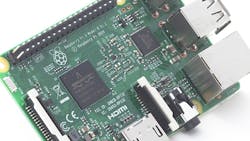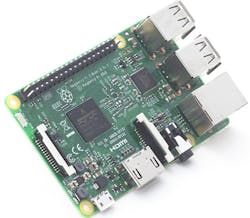The Raspberry Pi 3 Model B (Fig. 1) is here and it is sporting Wi-Fi, Bluetooth and a 64-bit, quad-core, ARM Cortex-A53 Broadcom BCM2837 SoC. It uses the same form factor as the Raspberry Pi 2 Model B and it shares many of the same features (see table below). The main limitation is the 1 Gbyte of DDR2 SDRAM. This is the same amount of memory as the Raspberry Pi 2 Model B, but it does keep the cost down. Flash storage is via a Micro-SD slot. It typically has a card holding a Linux operating system. Both are available for only $35.
The BCM2837 runs at 1.2 GHz. That alone gives a significant performance boost, but add in the 64-bit platform and the improved ARMv8-A architecture and the new chip provides more than a 50% performance improvement. The ARMv8-A architecture adds new instructions in addition to 64-bit support. It also supports the 32-bit A32 instructions as well as the 16-bit Thumb instructions.
The BCM2837 has the same VideoCore IV GPU as the BCM2836 found in the Raspberry Pi 2 Model B, although the newer version runs at 400 MHz. This provides compatibility with existing software. The GPU supports 1080p via HDMI (but not 4K,which is becoming more popular for high-end systems.)
The Raspberry Pi 3 Model B has the same wired interfaces including four USB 2.0 ports, 10/100 Ethernet, a camera interface, and the 40 GPIO header. There is an audio headphone output port and the HDMI has audio support as well. Video outputs include HDMI and composite video.
The big change, other than the processor, is the wireless interfaces. These include 802.11n and Bluetooth 4.0/BLE. Developers using older Raspberry Pi platforms had to resort to peripheral boards or USB adapters.
Adding Bluetooth allows systems access to Bluetooth keyboards and mice simplifying setup and freeing up USB ports. It is now possible to use four USB-based BitScopes (see “BitScoping With The Raspberry Pi” on electronicdesign.com) and still have a keyboard and mouse connected to the system via Bluetooth. Of course, this scenario works with other USB devices as well.
The Wi-Fi support often eliminates the need for wired Ethernet networking; 802.11n is not cutting-edge, but it is close and likely more than what most applications or users will require.
One nice feature of the Raspberry Pi 3 Model B is that the processor speed is adaptable. It runs at 600 MHz when the system is idling. This can improve power requirements. At full speed, the Raspberry Pi 3 Model B uses about 3.8 W, more than the 32-bit platform.
One advantage of keeping so many similarities between versions is software compatibility. The main differences are the addition of Wi-Fi and Bluetooth, which are easily hidden behind the network protocol stacks. Changing something like the GPU would have resulted in major changes to the system.
Raspberry Pi Foundation has done a great job with the Raspberry Pi 3 Model B. It will likely push older versions to the side, given its performance and functionality—although it does not eliminate the need for the tiny Raspberry Pi Zero. A Compute Module based on the new chip has not been announced yet but it is much anticipated.
The Raspberry Pi 3 Model B is available from Newark/element14.
About the Author
William G. Wong
Senior Content Director - Electronic Design and Microwaves & RF
I am Editor of Electronic Design focusing on embedded, software, and systems. As Senior Content Director, I also manage Microwaves & RF and I work with a great team of editors to provide engineers, programmers, developers and technical managers with interesting and useful articles and videos on a regular basis. Check out our free newsletters to see the latest content.
You can send press releases for new products for possible coverage on the website. I am also interested in receiving contributed articles for publishing on our website. Use our template and send to me along with a signed release form.
Check out my blog, AltEmbedded on Electronic Design, as well as his latest articles on this site that are listed below.
You can visit my social media via these links:
- AltEmbedded on Electronic Design
- Bill Wong on Facebook
- @AltEmbedded on Twitter
- Bill Wong on LinkedIn
I earned a Bachelor of Electrical Engineering at the Georgia Institute of Technology and a Masters in Computer Science from Rutgers University. I still do a bit of programming using everything from C and C++ to Rust and Ada/SPARK. I do a bit of PHP programming for Drupal websites. I have posted a few Drupal modules.
I still get a hand on software and electronic hardware. Some of this can be found on our Kit Close-Up video series. You can also see me on many of our TechXchange Talk videos. I am interested in a range of projects from robotics to artificial intelligence.



